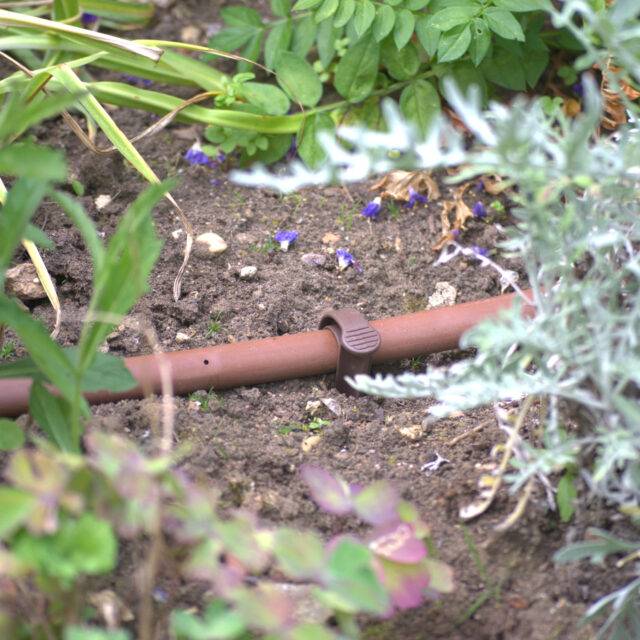
Hand watering wastes time and water
Watering planted borders in a garden can be time consuming and waste large amounts of water through evaporation. After a hot day, many people get the hose out to water the border. Not only does this waste a pleasant evening, but most of the water will also be wasted – some estimates show that 80% of the water will be lost when watering with a hose in hot weather.
Drip watering of garden borders for efficiency
The most efficient method of watering a border is a drip irrigation system. And the most efficient time to water is early in the morning, allowing the plants to absorb the water before the heat of the day.
Unlike sprinklers, drip irrigation systems put the water directly into the root zone. No spray means very little evaporation and efficiency rates close to 100%. Modern, commercial grade, drip lines have high precision drippers along their length providing uniform output down the length of the border. If the drippers do become blocked, self-flushing mechanisms will automatically flush the nozzle through.
Benefits of garden border watering
New planting and borders that are regularly watered will establish more quickly and losses are greatly reduced. To grow, the plants need sunshine and water, so without an efficient garden irrigation system the plants will struggle to thrive when the weather is warm and dry. With irrigation, the plants can take advantage of the long days of sunlight to grow quickly over the summer months.
Installing drip line on a garden border
 The dripline is installed as a grid of pipes, joined at one end. For garden borders the first line will be parallel to the front of the border and 25cm – 30cm away from the front. The second line, and all subsequent lines will be parallel to this but this time 50cm – 60cm further back. As a simple rule, if you take the width of the border in meters, the number of lines will be double this.
The dripline is installed as a grid of pipes, joined at one end. For garden borders the first line will be parallel to the front of the border and 25cm – 30cm away from the front. The second line, and all subsequent lines will be parallel to this but this time 50cm – 60cm further back. As a simple rule, if you take the width of the border in meters, the number of lines will be double this.
The dripline is uncoiled, and plastic pegs are fitted every 1m or so to hold it in place. At the end nearest the water supply the ends of the pipe are joined together with a header pipe and a single water inlet point. Each line at the other end is capped off.
Bringing water to the border
For established gardens a hose snap connector can be added to the start of the border watering system. When watering is required, the hose is taken to the border and the system turned on until the watering is complete.
For new borders an underground pipe can be laid from the tap to the border, permanently connecting the border to the water supply. A timer at the tap end will allow the watering to be completely automated.
Water Regulations
UK Water Regulations require a DB valve to be fitted to dripline systems. This protects the mains water supply from the danger of contaminated water flowing back into the mains.
Other methods of watering garden borders
Drip irrigation is the most efficient way of watering borders, but other methods include pop-up sprinklers mounted at the front of the border and spray sprinklers laid in the border itself.
Spray systems are less efficient than border drip watering but are easier to install on established beds as there is less pipework to install. However, these systems are more prone to dry spots and larger plants will block the spray.